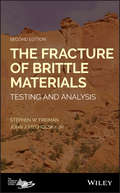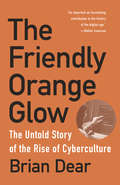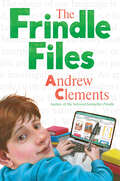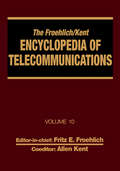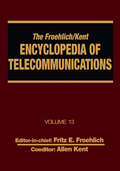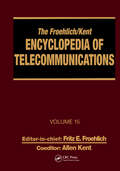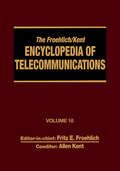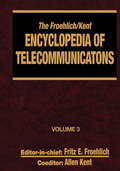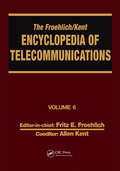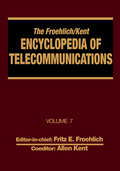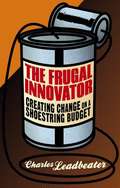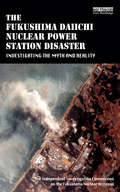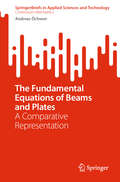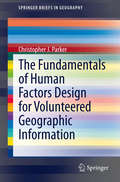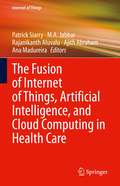- Table View
- List View
The Fracture of Brittle Materials: Testing and Analysis
by Stephen W. Freiman John J. Mecholsky Jr.Provides a modern, practical approach to the understanding and measurement procedures relevant to the fracture of brittle materials <P><P>This book examines the testing and analysis of the fracture of brittle materials. Expanding on the measurement and analysis methodology contained in the first edition, it covers the relevant measurements (toughness and strength), material types, fracture mechanics, measurement techniques, reliability and lifetime predictions, microstructural considerations, and material/test selection processes appropriate for the analysis of the fracture behavior of brittle materials. <P><P>The Fracture of Brittle Materials: Testing and Analysis, Second Edition summarizes the concepts behind the selection of a test procedure for fracture toughness and strength, and goes into detail on how the statistics of fracture can be used to assure reliability. <P><P>It explains the importance of the role of microstructure in these determinations and emphasizes the use of fractographic analysis as an important tool in understanding why a part failed. The new edition includes a significant quantity of material related to the fracture of biomaterials, and features two new chapters—one on thermal shock, the other on the modeling of the fracture process. <P><P>It also expands on a discussion of how to treat the statistics of fracture strength data to ensure reliability. Provides practical analysis of fracture toughness and strength Introduces the engineering and materials student to the basic concepts necessary for analyzing brittle fracture <P><P>Contains new statistical analysis procedures to allow for the prediction of the safe design of brittle components <P><P>Contains real-world examples to assist the reader in applying the concepts to their own research, material development, and quality-control needs <P><P> The Fracture of Brittle Materials: Testing and Analysis, Second Edition is an important resource for all students, technicians, engineers, scientists, and researchers involved in the study, analysis, creation, or testing of ceramics.
The Franklin Stove: An Unintended American Revolution
by Joyce E. ChaplinA Washington Post Noteworthy Book of March"From Joyce Chaplin's engaging, wide-ranging pages a fresh Franklin emerges." —Stacy Schiff, Pulitzer Prize–winning author of The Revolutionary"[Chaplin's] expansive claims for the Franklin stove’s importance click into place." —Dan Piepenbring, Harper's"A fascinating, innovative, inventive look at a fascinating, innovative man and his inventions." —Charles C. Mann, bestselling author of The Wizard and the Prophet and 1491The surprising story of Benjamin Franklin’s most famous invention—and a new take on the Founding Father we thought we knew. The biggest revolution in Benjamin Franklin’s lifetime was made to fit in a fireplace. Assembled from iron plates like a piece of flatpack furniture, the Franklin stove became one of the era's most iconic consumer products, spreading from Pennsylvania to England, Italy, and beyond. It was more than just a material object, however—it was also a hypothesis. Franklin was proposing that, armed with science, he could invent his way out of a climate crisis: a period of global cooling known as the Little Ice Age, when unusually bitter winters sometimes brought life to a standstill. He believed that his stove could provide snug indoor comfort despite another, related crisis: a shortage of wood caused by widespread deforestation. And he conceived of his invention as equal parts appliance and scientific instrument—a device that, by modifying how heat and air moved through indoor spaces, might reveal the workings of the atmosphere outside and explain why it seemed to be changing. With his stove, Franklin became America’s first climate scientist.Joyce E. Chaplin’s The Franklin Stove is the story of this singular invention, and a revelatory new look at the Founding Father we thought we knew. We follow Franklin as he promotes his stove in Britain and France, while corresponding with the various experimenters who discovered the key gases in Earth's atmosphere, invented steam engines, and tried to clean up sooty urban air. During his travels back and forth across the Atlantic, we witness him taking measurements of the gulf stream and observing the cooling effect of volcanic ash from Iceland. And back in Philadelphia, we watch him hawk his invention while sparring with proponents of the popular theory that clearcutting forests would lead to warmer winters by reducing the amount of shade cover on the surface of the Earth. As the story of the Franklin stove shows, it’s not so easy to engineer our way out of a climate crisis; with this book, Chaplin reveals how that challenge is as old as the United States itself.
The Fresh Honey Cookbook: 84 Recipes from a Beekeeper's Kitchen
by Laurey MastertonIndulge your sweet tooth all year long with honey’s many seasonal flavors. Use avocado honey to add depth to April’s baby carrots; spice up your July peaches with sourwood honey; and add some cranberry honey to November’s Thanksgiving spread. This delightful book is filled with bits of honey lore and beekeeping history to sweeten your exploration of the varied and delicious ways you can use honey every day.
The Friendly Orange Glow: The Untold Story of the PLATO System and the Dawn of Cyberculture
by Brian DearAt a time when Steve Jobs was only a teenager and Mark Zuckerberg wasn’t even born, a group of visionary engineers and designers—some of them only high school students—in the late 1960s and 1970s created a computer system called PLATO, which was light-years ahead in experimenting with how people would learn, engage, communicate, and play through connected computers. Not only did PLATO engineers make significant hardware breakthroughs with plasma displays and touch screens but PLATO programmers also came up with a long list of software innovations: chat rooms, instant messaging, message boards, screen savers, multiplayer games, online newspapers, interactive fiction, and emoticons. Together, the PLATO community pioneered what we now collectively engage in as cyberculture. They were among the first to identify and also realize the potential and scope of the social interconnectivity of computers, well before the creation of the internet. PLATO was the foundational model for every online community that was to follow in its footsteps. The Friendly Orange Glow is the first history to recount in fascinating detail the remarkable accomplishments and inspiring personal stories of the PLATO community. The addictive nature of PLATO both ruined many a college career and launched pathbreaking multimillion-dollar software products. Its development, impact, and eventual disappearance provides an instructive case study of technological innovation and disruption, project management, and missed opportunities. Above all, The Friendly Orange Glow at last reveals new perspectives on the origins of social computing and our internet-infatuated world.
The Friendship Experiment
by Erin TeaganFuture scientist Madeline Little is dreading the start of middle school. Nothing has been right since her grandfather died and her best friend changed schools. Maddie would rather help her father in his research lab or write Standard Operating Procedures in her lab notebook than hang out with a bunch of kids who aren't even her friends. Despite Maddie's reluctance, some new friends start coming her way--until they discover what she's written in that secret notebook. And that's just part of the trouble. Can this future scientific genius find the formula for straightening out her life?
The Frindle Files
by Andrew ClementsIn the long-awaited follow-up to the beloved classic Frindle, a new generation of kids discovers the power of words and imagination – and yes, even screens – to solve a mystery and change their world! &“A fitting final work from a master storyteller.&”—Kirkus Reviews Josh Willet is a techie, a serious gamer. Which is why Josh and his friends can&’t stand Mr. N&’s ELA class; it&’s a strict no-tech zone. Mr. N makes them write everything out by hand, he won&’t use a Smartboard, and he&’s obsessed with some hundred-year-old grammar book. Then Josh discovers a secret; turns out Mr. N's been keeping a lot more than technology from his students! Together with his best friend Vanessa, and using all the computer skills they&’ve got, Josh is determined to solve the mystery of Mr. N&’s past. And maybe get some screentime back, too? Andrew Clements&’s final novel is a timely one—about the importance of language, the changes that come along with technology (good and bad), and how sometimes you have to challenge what you think you know. Set a whole generation later, this novel can be read on its own or alongside Frindle and is destined to become another timeless classic.
The Froehlich/Kent Encyclopedia of Telecommunications: Volume 10 - Introduction to Computer Networking to Methods for Usability Engineering in Equipment Design
by Allen Kent Fritz E. FroehlichIntroduction to Computer Networking to Methods for Usability Engineering in Equipment Design.
The Froehlich/Kent Encyclopedia of Telecommunications: Volume 13 - Network-Management Technologies to NYNEX
by Allen Kent Fritz E. FroehlichThis article reviews network-management problems, technologies and standards, outlining the problems and challenges of the field. It overviews the functions and architectures, of various components of network-management systems (NMSs), describing key network-management application areas.
The Froehlich/Kent Encyclopedia of Telecommunications: Volume 15 - Radio Astronomy to Submarine Cable Systems
by Allen Kent Fritz E. FroehlichThis is volume fifteen of the Encyclopedia of Telecommunications, which covers Radio Astronomy to Submarine Cable Systems in alphabetical listing and information on the contributors
The Froehlich/Kent Encyclopedia of Telecommunications: Volume 18 - Wireless Multiple Access Adaptive Communications Technique to Zworykin: Vladimir Kosma
by Allen Kent Fritz E. FroehlichVolume 18- Wireless Multiple Access Adaptive Communications Technique to Zworykin, Vladimir Kosma. The only continuing source that helps users analyze, plan, design, evaluate, and manage integrated telecommunications networks, systems, and services, The Froehlich/Kent Encyclopedia of Telecommunications presents both basic and technologically advanced knowledge in the field. An ideal reference source for both newcomers as well as seasoned specialists, the Encyclopedia covers seven key areas--Terminals and Interfaces; Transmission; Switching, Routing, and Flow Control; Networks and Network Control; Communications Software and Protocols; Network and system Management; and Components and Processes.
The Froehlich/Kent Encyclopedia of Telecommunications: Volume 3 - Codes for the Prevention of Errors to Communications Frequency Standards
by Allen Kent Fritz E. Froehlich"The only continuing source that helps users analyze, plan, design, evaluate, and manage integrated telecommunications networks, systems, and services, The Froehlich/Kent Encyclopedia of Telecommunications presents both basic and technologically advanced knowledge in the field. An ideal reference source for both newcomers as well as seasoned specialists, the Encyclopedia covers seven key areas--Terminals and Interfaces; Transmission; Switching, Routing, and Flow Control; Networks and Network Control; Communications Software and Protocols; Network and system Management; and Components and Processes."
The Froehlich/Kent Encyclopedia of Telecommunications: Volume 6 - Digital Microwave Link Design to Electrical Filters
by Allen Kent Fritz E. Froehlich"The only continuing source that helps users analyze, plan, design, evaluate, and manage integrated telecommunications networks, systems, and services, The Froehlich/Kent Encyclopedia of Telecommunications presents both basic and technologically advanced knowledge in the field. An ideal reference source for both newcomers as well as seasoned specialists, the Encyclopedia covers seven key areas--Terminals and Interfaces; Transmission; Switching, Routing, and Flow Control; Networks and Network Control; Communications Software and Protocols; Network and system Management; and Components and Processes."
The Froehlich/Kent Encyclopedia of Telecommunications: Volume 7 - Electrical Filters: Fundamentals and System Applications to Federal Communications Commission of the United States
by Allen Kent Fritz E. Froehlich"The only continuing source that helps users analyze, plan, design, evaluate, and manage integrated telecommunications networks, systems, and services, The Froehlich/Kent Encyclopedia of Telecommunications presents both basic and technologically advanced knowledge in the field. An ideal reference source for both newcomers as well as seasoned specialists, the Encyclopedia covers seven key areas--Terminals and Interfaces; Transmission; Switching, Routing, and Flow Control; Networks and Network Control; Communications Software and Protocols; Network and system Management; and Components and Processes."
The Frugal Homesteader: Living the Good Life on Less
by John Moody&“Practical advice . . . from the farm field to foraging in the forest . . . a must-have for anyone looking to transition from homeowner to homesteader.&”—Scott Mann, host of The Permaculture Podcast Build your homesteading dreams with all the affordable DIY innovations, tips, and stories you need to successfully launch you on a path to self-sufficiency. Raise and grow your own food, connect with nature, and consume less while producing more!The Frugal Homesteader is a fun, inspirational, and educational guide filled with a lifetime of learning that comes along with becoming a homesteader. Following dozens of successful families who have been motivated to make do, make new, and make more while saving money and living off the land, this book covers such topics as:Outfitting your garden Equipping your barn and outbuildings Protecting and providing for your animals Harvesting rainwater Heating with wood Foraging Producing more of what you need to thrive in harder times. Whether you&’re just starting out and looking for new, sustainable, and affordable ideas, approaches, and techniques, or you&’re a small-scale farmer in regenerative agriculture, The Frugal Homesteader is the DIY manual to help you succeed. &“This book is worth its weight in gold . . . an account of direct lived experience: jam-packed with tips and tricks from doing the homestead life each and every day.&”—Ben Falk, homesteader and author of The Resilient Farm and Homestead &“This is a rich bounty of ideas that will be equally usefully to old hands and shiny new start-ups alike, whether on rural acreage or urban lot.&”—Jenni Blackmore, author of The Food Lover&’s Garden
The Frugal Innovator
by Charles LeadbeaterThis insightful book looks at the phenomenon of low-cost innovation and explores what we can learn from the innovators in developing nations who are making amazing technical and social advances with scarce capital and resources. Charles Leadbeater shows how these methods can be applied and used wherever you are and whatever your capital.
The Fruits We Eat
by Gail GibbonsBerries, apples, melons, and grapes; oranges, grapefruits, bananas -- yum! This scrumptious picture book, a companion to The Vegetables We Eat, offers youngsters an inviting, information-packed cornucopia of favorite fruits. Gail Gibbons combines a clear, simple text with her signature illustrations to present fruit facts galore: the parts of fruits, where and how they grow, harvesting, processing, where to buy them, and how to enjoy them as part of a healthy diet.
The Fruits We Eat (New & Updated)
by Gail GibbonsFrom #1 science writer for kids Gail Gibbons, learn everything about the delicious fruits you eat with this new and updated edition.Berries, apples, melons, and grapes; oranges, grapefruits, bananas -- yum! This scrumptious, updated picture book, a companion to The Vegetables We Eat, offers youngsters an inviting, information-packed cornucopia of favorite fruits.Gail Gibbons combines a clear, simple text with her signature illustrations to present fruit facts galore: the parts of fruits, where and how they grow, harvesting, processing, where to buy them, and how to enjoy them as part of a healthy diet.
The Fukushima Daiichi Nuclear Power Station Disaster: Investigating the Myth and Reality
by The Fukushima Nuclear AccidentWhen the Nuclear Safety Commission in Japan reviewed safety-design guidelines for nuclear plants in 1990, the regulatory agency explicitly ruled out the need to consider prolonged AC power loss. In other words, nothing like the catastrophe at the Fukushima Daiichi Nuclear Power Station was possible—no tsunami of 45 feet could swamp a nuclear power station and knock out its emergency systems. No blackout could last for days. No triple meltdown could occur. Nothing like this could ever happen. Until it did—over the course of a week in March 2011. In this volume and in gripping detail, the Independent Investigation Commission on the Fukushima Nuclear Accident, a civilian-led group, presents a thorough and powerful account of what happened within hours and days after this nuclear disaster, the second worst in history. It documents the findings of a working group of more than thirty people, including natural scientists and engineers, social scientists and researchers, business people, lawyers, and journalists, who researched this crisis involving multiple simultaneous dangers. They conducted over 300 investigative interviews to collect testimony from relevant individuals. The responsibility of this committee was to act as an external ombudsman, summarizing its conclusions in the form of an original report, published in Japanese in February 2012. This has now been substantially rewritten and revised for this English-language edition. The work reveals the truth behind the tragic saga of the multiple catastrophic accidents at the Fukushima Daiichi Nuclear Power Station.It serves as a valuable and essential historical reference, which will help to inform and guide future nuclear safety and policy in both Japan and internationally.
The Fulton Fish Market: A History (Arts and Traditions of the Table: Perspectives on Culinary History)
by Jonathan H. ReesThe Fulton Fish Market stands out as an iconic New York institution. At first a neighborhood retail market for many different kinds of food, it became the nation’s largest fish and seafood wholesaling center by the late nineteenth century. Waves of immigrants worked at the Fulton Fish Market and then introduced the rest of the city to their seafood traditions. In popular culture, the market—celebrated by Joseph Mitchell in The New Yorker—conjures up images of the bustling East River waterfront, late-night fishmongering, organized crime, and a vanished working-class New York.This book is a lively and comprehensive history of the Fulton Fish Market, from its founding in 1822 through its move to the Bronx in 2005. Jonathan H. Rees explores the market’s workings and significance, tracing the transportation, retailing, and consumption of fish. He tells the stories of the people and institutions that depended on the Fulton Fish Market—including fishermen, retail stores, restaurants, and chefs—and shows how the market affected what customers in New York and around the country ate. Rees examines transformations in food provisioning systems through the lens of a vital distribution point, arguing that the market’s wholesale dealers were innovative businessmen who adapted to technological change in a dynamic industry. He also explains how changes in the urban landscape and economy affected the history of the market and the surrounding neighborhood.Bringing together economic, technological, urban, culinary, and environmental history, this book demonstrates how the Fulton Fish Market shaped American cuisine, commerce, and culture.
The Functional Foods Revolution: "Healthy People, Healthy Profits"
by Michael Heasman Julian MellentinFoods that promote human health - 'functional foods' or nutraceuticals - have caught the imagination of the global food industry. All the household-name companies are developing them as a key driver in their global strategies. They see the prospect of new markets and bigger margins, but the issues presented are fraught with complexity and difficulties. Distinguishing hype from real hope, the authors of this handbook explain the dilemmas and contradictions the industry faces. They present a wealth of detailed marketing, food policy and regulatory material from the leading markets world-wide and show how the hopes of the industry, and the consumer, may be dashed. The solution they offer is radical - nothing less than a new business model of what they term a healthful company.
The Fundamental Equations of Beams and Plates: A Comparative Representation (SpringerBriefs in Applied Sciences and Technology)
by Andreas ÖchsnerThis book focuses on beam and plate elements, essential components found across various fields from automotive and aerospace engineering to civil engineering structures. It offers a comparative exploration of the fundamental equations governing thin and thick beams, as well as thin and thick plates, providing readers with a clear understanding of these foundational structural elements. By explaining the three fundamental equations of continuum mechanics—equilibrium, kinematics, and constitution—the text culminates in a unified differential equation framework, offering both beginners and experienced practitioners a fresh perspective on structural member modeling.
The Fundamentals of Human Factors Design for Volunteered Geographic Information
by Christopher J. ParkerThis book explores the roles in which volunteered and professional information play within neogeography from a human factors perspective. The unique advantages of each information type are considered alongside how they may be utilised to create products and services delivering highly functional, efficient and satisfying experiences to their users. The overall aim of this book is to address the issue of how Volunteered Geographic Information (VGI) can be combined with Professional Geographic Information (PGI) to satisfy the information search requirements of consumer-users via highly usable mashups. Firstly, this required the development of an understanding of the way different users perceive VGI and PGI in terms of its benefits to their activities and information needs. Secondly, the benefits that VGI may bring to the user experience of a mashup (which cannot be attained through the use of PGI) needed to be understood. In order to achieve this, a user centred design perspective was implemented throughout the research.
The Fundamentals of Process Intensification
by Andrzej Stankiewicz Tom Van Gerven Georgios StefanidisThis advanced textbook covering the fundamentals and industry applications of process intensification (PI) discusses both the theoretical and conceptual basis of the discipline. Since interdisciplinarity is a key feature of PI, the material contained in the book reaches far beyond the classical area of chemical engineering. Developments in other relevant disciplines, such as chemistry, catalysis, energy technology, applied physics, electronics and materials science, are extensively described and discussed, while maintaining a chemical engineering perspective. Divided into three major parts, the first introduces the PI principles in detail and illustrates them using practical examples. The second part is entirely devoted to fundamental approaches of PI in four domains: spatial, thermodynamic, functional and temporal. The third and final part explores the methodology for applying fundamental PI approaches in practice. As well as detailing technologies, the book focuses on safety, energy and environmental issues, giving guidance on how to incorporate PI in plant design and operation -- safely, efficiently and effectively.
The Fundamentals of Quality Assurance in the Textile Industry
by Stanley Bernard BrahamsThe role of quality assurance is to ensure that once a specification has been agreed, every product and every production run meets that standard. The Fundamentals of Quality Assurance in the Textile Industry describes how quality professionals in the apparel industry coordinating with overseas factories can ensure excellence. The author explains what tools are required and how to manage products from style conception to finished production and the methods used to track and evaluate samples and production at each stage of the critical path. This book reinforces the concept that quality assurance must become an integral part of the business and details crucial procedures that have been adopted internationally.
The Fusion of Internet of Things, Artificial Intelligence, and Cloud Computing in Health Care (Internet of Things)
by Ajith Abraham Patrick Siarry Ana Madureira M. A. Jabbar Rajanikanth AluvaluThis book reviews the convergence technologies like cloud computing, artificial intelligence (AI) and Internet of Things (IoT) in healthcare and how they can help all stakeholders in the healthcare sector. The book is a proficient guide on the relationship between AI, IoT and healthcare and gives examples into how IoT is changing all aspects of the healthcare industry. Topics include remote patient monitoring, the telemedicine ecosystem, pattern imaging analytics using AI, disease identification and diagnosis using AI, robotic surgery, prediction of epidemic outbreaks, and more. The contributors include applications and case studies across all areas of computational intelligence in healthcare data. The authors also include workflow in IoT-enabled healthcare technologies and explore privacy and security issues in healthcare-based IoT.
